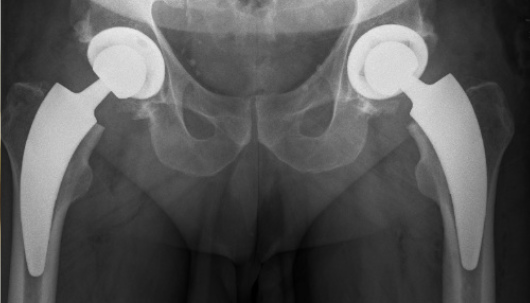
17 Jun Simultaneous bilateral hip replacement: Progress makes it possible
Simultaneous bilateral hip replacement: Progress makes it possible
Medical and technological advances—particularly minimally invasive surgical techniques, innovative implants such as the A2® short stem, and optimized procedures—now make it possible to implant both hip endoprostheses in a single session. Dr. Mumme Schüller, Cloppenburg, and his team have already performed several of these procedures and share their experiences in this interview.
ARTIQO: For which patients is such a simultaneous bilateral procedure suitable?
Dr. Schüller: One might assume that this procedure is only possible for patients without pre-existing conditions. However, I believe it is suitable for all patients – even older ones – who have bilateral grade 4 osteoarthritis. In cases of pre-existing conditions, bilateral THA may even be the better solution due to the single anesthetic. However, the majority of patients we treat this way are younger.
ARTIQO: How is the decision for bilateral surgery made?
Dr. Schüller: If the indication is confirmed by X-rays and the risk for the individual patient can be well assessed, we offer the option of treating both hips in a single session. We make the decision together with the patient, discussing the advantages, disadvantages, and risks in detail. We now have patients who deliberately come to us for this option, even though we haven’t advertised it. Word simply gets around. From the patient’s perspective, the reasons include fear of the side effects of anesthesia or the desire to return to work more quickly. Economically, this is not as lucrative for the clinic operator as two separate operations. It’s good for our patient flow.
ARTIQO: What should be considered intraoperatively?
Dr. Schüller: We routinely administer tranexamic acid intravenously to minimize blood loss. Positioning is also important. We start on the right, unposition the patient, turn the table over, and reposition. Thus, in terms of infection prevention, our setting is similar to two surgeries. Finally, we routinely operate on patients minimally invasively via the DAA approach.
ARTIQO: What about implant selection?
Dr. Schüller: Of the 30 cases we have operated on bilaterally in a single session so far, we have treated approximately 70% with the A2® Short Stem. This is partly due to the instrumentation. The impactor is beautifully delicate. The implant itself follows the natural curvature of the calcar. This makes it easier with the small incisions with the anterior approach. Without rushing, we usually need 40 minutes per side from incision to suture, meaning we don’t have to extend the operating time.
ARTIQO: What changes postoperatively, for example, in patient mobilization?
Dr. Schüller: In principle, patients are allowed to bear full weight on both sides, with the aid of forearm crutches. Initially, this was less of an issue for patients than with physiotherapy. It took some convincing, but now they’ve adapted to patients receiving bilateral support. The outpatient rehabilitation center nearby also works well with these patients. It’s more difficult at the inpatient rehabilitation clinics in the surrounding area. More coordination is needed here.
ARTIQO: What are your conclusions regarding simultaneous bilateral treatment?
Dr. Schüller: Thanks to the minimally invasive procedure, these patients benefit from less blood loss, fewer complications, shorter hospital stays, and faster rehabilitation. The total treatment time in the hospital and in rehabilitation is shorter than with two separate procedures. We typically have hospital stays of five days, but depending on the patient’s general condition, they can be two or three days longer. However, we don’t end up with double the length of stay.
The patients who return from rehabilitation are very satisfied. The number one positive we hear again and again is: “With one operation, I can get through everything.”
The biggest challenge with this procedure is interdisciplinary coordination with colleagues from anesthesiology, physiotherapy, and rehabilitation. This requires persuasion and agreement.


